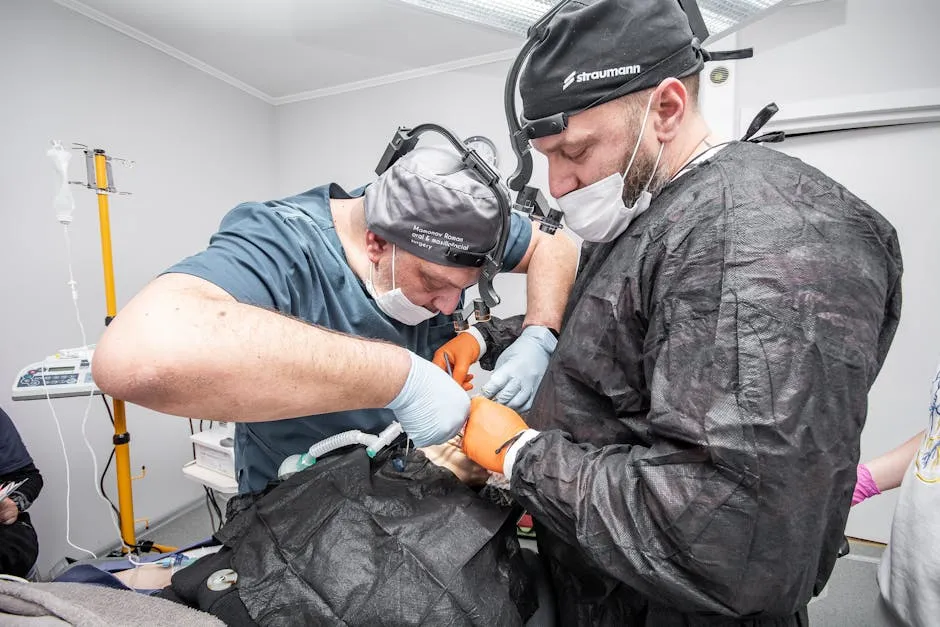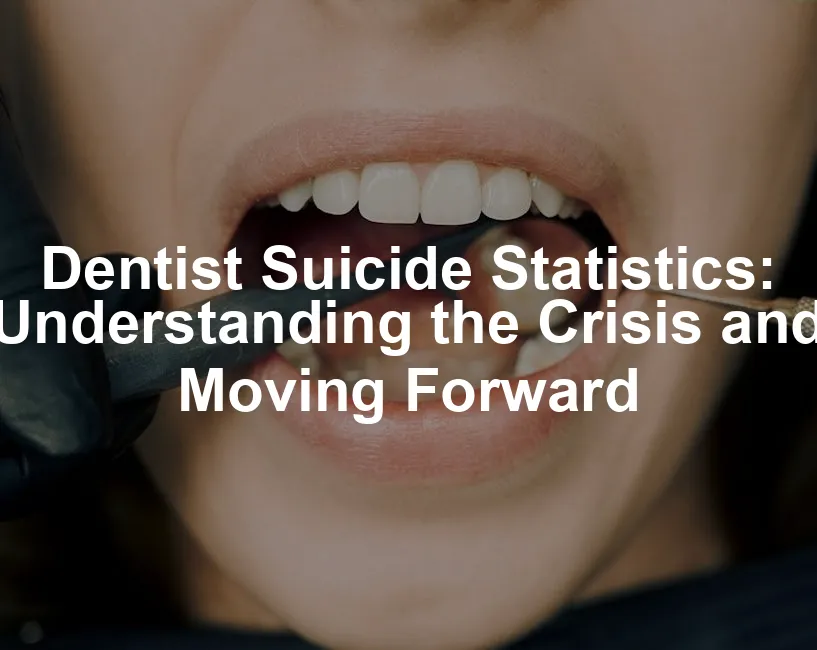Introduction
Suicide among dentists is a growing concern. Alarming statistics reveal that dentists face a significantly higher risk of suicide compared to other professions. The reported suicide rate for dentists stands at 7.18%, a staggering figure when compared to the national average of just 0.42%. These numbers are not just statistics; they represent real lives affected by the pressures of the profession.
Understanding this issue is crucial. It sheds light on the mental health challenges dental professionals encounter daily. The purpose of this article is to inform readers about these concerning statistics, the contributing factors behind them, and the preventive measures that can be implemented. We aim to provide insights that foster a supportive environment for dentists and encourage open discussions around mental health.
Unfortunately, a stigma persists surrounding mental health in dentistry. Many dental professionals feel compelled to maintain a facade of strength, fearing judgment or repercussions for acknowledging their struggles. This culture of silence can exacerbate feelings of isolation and despair. By addressing these statistics and the underlying issues, we hope to pave the way for more constructive conversations about mental health within the dental community.

In the following sections, we will delve deeper into the statistics surrounding dentist suicides, exploring their implications and highlighting the urgent need for awareness and support. Together, we can work towards a future where mental health is prioritized, and dental professionals feel empowered to seek help without fear.
Understanding the Statistics
Overview of Dentist Suicide Rates
Recent studies have reinforced the alarming prevalence of suicide within the dental profession. The suicide rate among dentists is currently estimated at 7.18%, which is alarmingly higher than many other fields. For context, this figure means that dentists are over 17 times more likely to take their own lives compared to the general population. In comparison, the suicide rate for other health professionals, such as physicians and nurses, hovers around 7.87% and 6.56%, respectively. This places dentists among the most vulnerable groups in terms of mental health crisis.
Historical data shows that these distressing statistics have remained consistent, with suicide rates among dentists reported as significantly higher since the 1960s. This trend raises critical questions about the factors contributing to such elevated risks. The implications of these statistics are profound, highlighting the urgent need for systemic changes within the profession to address the mental health challenges faced by dentists.
The mental health landscape for dentists has not improved significantly over the years. Despite advancements in mental health awareness, many dental professionals still face overwhelming pressures, leading to increased stress and burnout. This crisis calls for immediate attention and action to provide better support systems for those in the dental field. To help with stress relief, consider a Weighted Blanket for Anxiety. It’s a cozy companion that can help ease those overwhelming feelings, making you feel secure and relaxed.

In summary, the suicide statistics among dentists paint a stark picture of a profession grappling with mental health challenges. By understanding the depth of the crisis, we can begin to construct meaningful solutions aimed at reducing these alarming rates and fostering a healthier work environment for dental professionals.
Comparison with Other Professions
When we look at suicide rates, dentists stand out in a troubling way. Research indicates that the suicide rate among dentists is notably higher than that of many other professions. For instance, a study revealed that dentists have a suicide rate of 7.18%. In comparison, physicians experience a rate of 7.87%, while nurses and pharmacists follow closely at 6.56% and 7.19%, respectively.
This data suggests that dentists grapple with a higher risk of suicide than many other healthcare professionals. While the numbers for physicians are alarmingly high, they still don’t reach the levels seen among dentists. The stark reality is that dentists are often over 17 times more likely to die by suicide compared to the general population, which has a national average of just 0.42%. This discrepancy raises questions about the unique pressures dentists face in their daily lives.

Misconceptions Around Suicide Rates
There are many myths swirling around the topic of suicide rates in dentistry. One common misconception is that dentists are inherently more prone to suicide than any other profession. While the statistics are certainly alarming, they do not paint the full picture. Many people believe that dentists have a suicide rate 2.5 to 5.5 times higher than other white-collar workers, a notion stemming from outdated studies and media representations.
This misinformation is often perpetuated by sensational media portrayals and anecdotal evidence. For instance, when a dentist takes their own life, it becomes a headline, reinforcing the stereotype that dentists are at an elevated risk. However, reliable data suggests that while mental health challenges are significant, the actual suicide statistics may not be as dire as commonly thought. It’s essential to differentiate between perception and reality, to understand that while dentists face unique stressors, the narrative around their suicide rates can sometimes be exaggerated.
Thus, it becomes crucial to create an environment where accurate information is shared, and the stigma surrounding mental health is addressed. By doing so, we foster a culture where dental professionals feel safe to speak out about their struggles, allowing for better support systems to be put in place. A great way to start is by investing in a Mental Health First Aid Kit—because everyone deserves to have the right tools for support.

Personality Traits and Perfectionism
Dentists often grapple with perfectionism. This trait can amplify stress and lead to mental health challenges. Many dental professionals set unrealistically high standards for themselves. This drive for perfection can turn routine tasks into monumental pressure. The constant pursuit of flawless results can lead to feelings of inadequacy. When they don’t meet these self-imposed benchmarks, anxiety and depression may follow.
Common personality traits among dentists include conscientiousness and a strong sense of responsibility. These characteristics, while beneficial for patient care, can also contribute to mental health struggles. Dentists frequently feel that their worth is tied to their performance. This mindset can create a vicious cycle of stress, burnout, and emotional exhaustion. The fear of making mistakes looms large, leading many to work excessively long hours. Ultimately, this intense focus on perfection can take a toll on their overall well-being.

Isolation and Stigma
Isolation is a significant issue for many dentists. Those in solo practices often feel lonely, lacking support from colleagues. The pressure to maintain a strong facade only exacerbates this feeling. Dentists frequently hide their struggles, fearing judgment from peers. This can lead to a troubling sense of solitude. With no one to share their burdens, many dentists spiral deeper into despair.
Stigma surrounding mental health remains a formidable barrier. Many dental professionals worry that acknowledging their struggles may harm their reputation. This fear can prevent them from seeking help. The culture of the dental profession often emphasizes strength and resilience, discouraging vulnerability. As a result, dentists may suffer in silence, unable to voice their challenges. Breaking this cycle of stigma is crucial for fostering a healthier work environment. To aid in relaxation and mindfulness, consider using a Aromatherapy Essential Oil Diffuser to create a calming atmosphere.

Substance Abuse and Addiction
Access to controlled substances poses a unique risk for dentists. Many have easy access to medications like nitrous oxide, which can lead to misuse. Stress and job demands often drive them toward substance use as a coping mechanism. The pressure to perform can lead some dentists to seek relief through unhealthy means.
Statistics reveal a troubling trend: around 10% of dentists may struggle with substance abuse issues. This figure highlights the extent of the problem within the profession. Dentists often turn to substances to cope with the emotional toll of their work. Unfortunately, this can lead to a cycle of addiction that further complicates their mental health challenges. Addressing these risks is vital for the well-being of dental professionals and their patients alike.

Prevention Strategies and Support Systems
Mental Health Initiatives
The mental health landscape for dental professionals is gradually improving, thanks to several initiatives aimed at providing support. One noteworthy program is the Dental Practitioner Support (DPS) initiative, which offers confidential advice and referrals for dental professionals facing mental health challenges. This program recognizes the unique pressures dentists experience and strives to create a safety net for those in need.
Dental schools are also stepping up to address mental health. They’re incorporating mental health education into their curricula, helping students to identify stressors early on. By equipping future dentists with coping strategies, schools aim to foster a supportive environment where mental well-being is prioritized. This shift can lead to a generation of dentists who feel more comfortable discussing their struggles and seeking help when necessary. You might also want to check out Guided Journal for Self-Reflection to help navigate those thoughts.

Community and Peer Support
Isolation can be a quiet killer in the dental profession. Many dentists work solo, leaving them vulnerable to feelings of loneliness. This is where peer support networks come into play. By forming connections with colleagues, dental professionals can combat isolation and share their experiences. Support groups provide a platform for dentists to discuss challenges openly, creating a sense of community.
Encouraging open dialogue is essential for fostering a safe environment. Dental practices can adopt strategies to promote discussions around mental health. For instance, regular team meetings can include mental health check-ins. This practice normalizes conversations about stress and encourages individuals to share their feelings without fear of judgment. When dental professionals feel safe to discuss their mental health, they can seek help sooner, leading to better outcomes.

Effective Coping Mechanisms
Coping mechanisms are vital for managing stress in the dental field. Simple self-care practices can work wonders. Mindfulness techniques, such as meditation and deep breathing exercises, can help dentists stay grounded during stressful situations. Exercise is also a fantastic stress reliever; even a brisk walk can boost mood and improve overall well-being. You can also enhance your mindfulness practice with a Meditation Cushion, making your sessions more comfortable.
Therapy is another powerful tool. Many professionals silently struggle, believing they should handle everything alone. Seeking therapy can provide a safe space to explore feelings and develop coping strategies. Whether through individual therapy or group sessions, connecting with a mental health professional can help dentists navigate their emotional landscape.
Moreover, it’s important to encourage help-seeking behaviors. Highlighting that asking for help is a strength, not a weakness, can shift the stigma surrounding mental health. By creating an environment that promotes seeking help, dental professionals will be more likely to utilize available resources. And remember, a Fitness Tracker can help you monitor your physical health, which is closely tied to your mental well-being.
Ultimately, fostering mental well-being in dentistry is a collective responsibility. By implementing mental health initiatives, promoting community support, and encouraging effective coping mechanisms, the dental profession can create a healthier, more resilient workforce. Together, we can combat the stigma and ensure that dental professionals prioritize their mental health just as they do their patients’.

Encouraging Help-Seeking Behaviors
Seeking help isn’t just a good idea; it’s essential. In the dental field, where pressures can feel like a heavy toothache, acknowledging the need for mental health support is vital. Unfortunately, many dental professionals hesitate to reach out due to persistent stigma surrounding mental health issues. This stigma can create an environment where whispers of struggle go unheard, leaving many dentists to suffer in silence.
Encouraging help-seeking behaviors starts with open conversations. By normalizing discussions about mental health, we can dismantle the barriers that prevent dental professionals from seeking the assistance they need. Sharing stories and experiences can foster a culture of support. Dentists should feel empowered to voice their challenges without fear of judgment or repercussions.
It’s important to understand that seeking help is a sign of strength, not weakness. Just like a patient wouldn’t ignore a cavity, dental professionals shouldn’t ignore their mental health. Engaging with mental health resources, such as counseling or peer support groups, can make a world of difference. These avenues provide safe spaces for individuals to express their feelings and receive guidance.
Furthermore, dental schools and organizations can play a pivotal role in this effort. Incorporating mental health education into curricula can equip future dentists with the tools to manage stress and recognize when to seek help. Workshops on coping strategies and resilience can prepare them for the inevitable challenges they will face in practice. A Self-Care Planner can also assist in tracking your wellness journey.

Ultimately, promoting help-seeking behaviors is a collective responsibility. As a community, we must stand together to reduce stigma and encourage everyone in the dental profession to prioritize their mental health. Together, we can cultivate an environment where seeking help is viewed as a proactive step toward well-being, ensuring that no one has to bear their burdens alone.
Conclusion
The mental health crisis in dentistry is a pressing issue that demands attention. The alarming statistics reveal a profession plagued by higher rates of suicide and mental health struggles compared to other fields. Addressing this crisis is not just important; it’s imperative for the well-being of dental professionals and their patients.
In summary, we must recognize the significance of mental health in the dental profession. The pressures faced by dentists, from financial burdens to patient expectations, can take a toll on their mental well-being. By fostering a supportive environment that encourages open conversations about mental health, we can begin to dismantle the stigma surrounding these issues.
It’s time for dental professionals to prioritize their mental health. Seeking help is not a sign of weakness; it’s a courageous step toward healing and resilience. Whether through therapy, peer support, or workplace initiatives, every dentist should feel empowered to reach out when they face challenges. And don’t forget to treat yourself with a cup of relaxation using an Herbal Tea Sampler for Relaxation.
The future outlook for mental health in dentistry hinges on continued research and support. Ongoing studies will help us better understand the factors contributing to mental health struggles in this profession. We must advocate for resources that enhance mental wellness and provide comprehensive support systems for dental professionals.
Together, we can cultivate a culture of care that prioritizes mental health and well-being in dentistry. By standing united, we can ensure that the next generation of dentists feels empowered to seek help and support, ultimately leading to a healthier profession for all.
FAQs
What are the common signs of mental health struggles among dentists?
Recognizing the signs of mental health struggles in dentists is crucial. Symptoms can vary significantly, but some common indicators include withdrawal from social interactions, noticeable changes in work quality, and emotional distress. A dentist who once thrived in their practice may begin to show signs of burnout, feeling overwhelmed by the demands of the job. Other signs may include increased irritability, difficulty concentrating, and a decline in motivation. If a dentist seems more anxious or expresses feelings of hopelessness, these may be red flags that indicate they are struggling. It’s essential for colleagues, friends, and family members to be vigilant and supportive. If you notice someone exhibiting these signs, encourage them to talk about their feelings and consider seeking professional help.
How can someone support a dentist facing mental health challenges?
Supporting a dentist facing mental health challenges is about being there and showing empathy. One effective way is to create an open dialogue. Encourage them to share their feelings, and actively listen without judgment. Sometimes, just knowing someone cares can make a significant difference. Additionally, reassure them that seeking help is okay. Encourage them to explore mental health resources, such as counseling or support groups. Offering to accompany them to appointments or helping them find a therapist can also be beneficial. Moreover, promoting a healthy work-life balance is essential. Encourage breaks, time off, and pursuing hobbies outside of work. Remind them that it’s okay to prioritize their well-being. By being a supportive friend or colleague, you can help reduce the stigma surrounding mental health in the dental profession.
What resources are available for dentists seeking help?
There are numerous resources available for dentists seeking help with mental health challenges. Organizations like the Dental Practitioner Support (DPS) provide confidential advice and referrals tailored to dental professionals. Additionally, the American Dental Association (ADA) offers various resources, including hotlines and support networks. Online platforms also offer valuable information. Websites like Mental Dental and Mindfulness for Dentists provide articles, tools, and community forums for dentists to connect and share experiences. Professional counseling services, both in-person and online, are widely accessible. Dentists can seek out therapists specializing in mental health for healthcare professionals. Remember, reaching out for help is a vital step toward better mental well-being.
Are there any specific studies or articles that address this issue?
Several studies and articles have explored the mental health crisis in dentistry. The Journal of Affective Disorders published an impactful study revealing that dentists have the highest suicide rates among health professionals, emphasizing the urgent need for support systems. Other notable works include research published in the Journal of Primary Care Dentistry and Oral Health, which reviews the risk factors and preventive measures for suicide in the dental profession. Additionally, articles from reputable sources like the American Dental Association discuss strategies to promote mental wellness among dentists. These resources underscore the importance of ongoing research and dialogue surrounding mental health in dentistry, providing valuable insights for both current practitioners and future generations.
Please let us know what you think about our content by leaving a comment down below!
Thank you for reading till here 🙂
All images from Pexels




